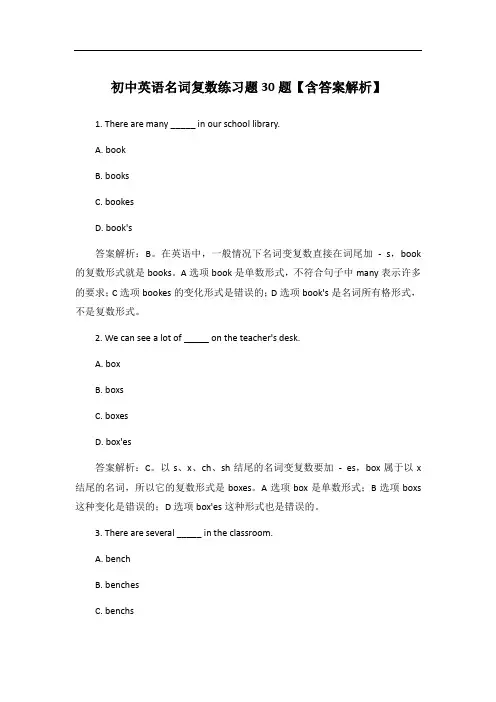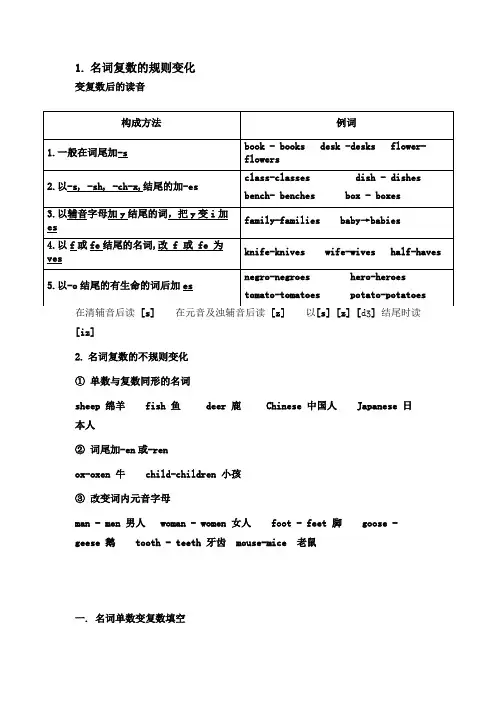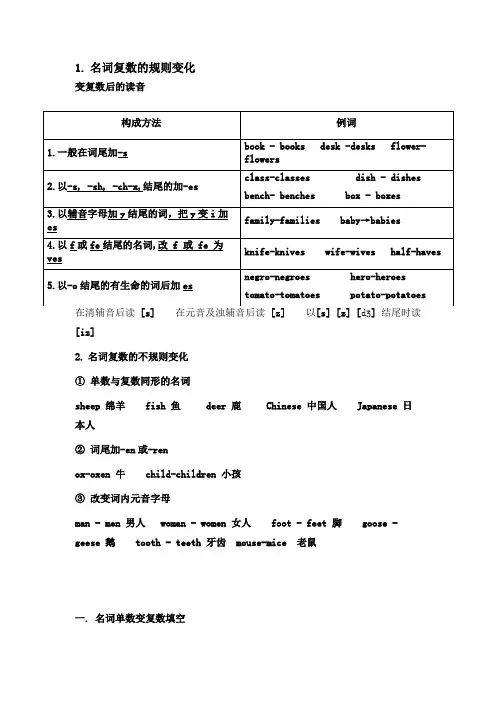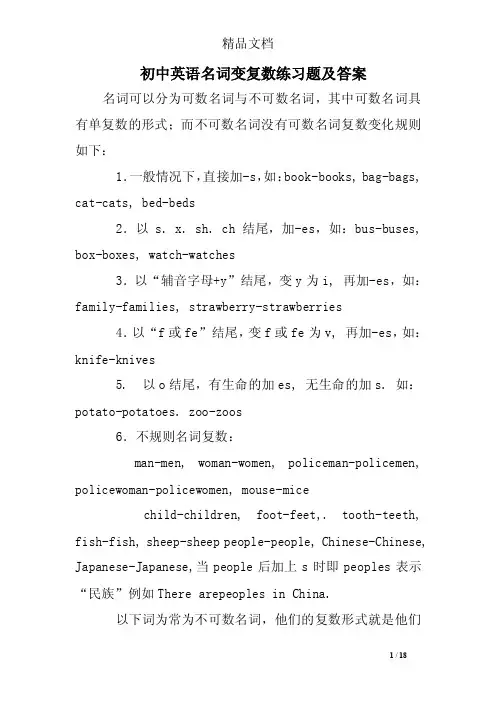初中英语专题之名词单复数变化及练习题
- 格式:doc
- 大小:46.00 KB
- 文档页数:8

初中英语名词复数练习题30题【含答案解析】1. There are many _____ in our school library.A. bookB. booksC. bookesD. book's答案解析:B。
在英语中,一般情况下名词变复数直接在词尾加-s,book 的复数形式就是books。
A选项book是单数形式,不符合句子中many表示许多的要求;C选项bookes的变化形式是错误的;D选项book's是名词所有格形式,不是复数形式。
2. We can see a lot of _____ on the teacher's desk.A. boxB. boxsC. boxesD. box'es答案解析:C。
以s、x、ch、sh结尾的名词变复数要加-es,box属于以x 结尾的名词,所以它的复数形式是boxes。
A选项box是单数形式;B选项boxs 这种变化是错误的;D选项box'es这种形式也是错误的。
3. There are several _____ in the classroom.A. benchB. benchesC. benchs答案解析:B。
以ch结尾的名词变复数要加- es,bench的复数形式是benches。
A选项bench是单数形式;C选项benchs这种变化是错误的;D选项bench'es 这种形式是错误的。
4. The students have many _____ in their pencil - boxes.A. penB. pensC. penesD. pen's答案解析:B。
一般情况下名词变复数直接加-s,pen的复数形式是pens。
A选项pen是单数形式;C选项penes这种变化是错误的;D选项pen's是名词所有格形式,不是复数形式。
5. There are some _____ on the playground.A. ballB. ballsC. ballesD. ball's答案解析:B。

1.名词复数的规则变化变复数后的读音[iz]2.名词复数的不规则变化①单数与复数同形的名词sheep 绵羊 fish 鱼 deer 鹿 Chinese 中国人 Japanese 日本人②词尾加-en或-renox-oxen 牛 child-children 小孩③改变词内元音字母man - men 男人 woman - women 女人 foot - feet 脚 goose - geese 鹅 tooth - teeth 牙齿 mouse-mice 老鼠一. 名词单数变复数填空1.orange text bed cakecomputer apple house quilt plane tree lesson banana shirt month cup parent2.piano photo radio zoo tomato potato hero negro3.class fox watch glass dress brush box bus4.shelf knife wife life leaf thief wolf5.family country army citystory baby butterfly6.toy day key boy7.sheep fish deer Chinese8.child ox man woman foot goose tooth mouse二.代词/ be动词单数变复数this ______ that _________ I _______ you ________she_______ he ________ it ________ am _____ is _______三:把下列的单词变为复数形式1.key2.boy3.family4.case5.backpack6.dictionary7.watchputer 9.game 10.notebook11.bag 12.math 13.alarm 14.video15.tape 16.hat 17.pear 18.egg19.apple 20.carrot 21.vegetable22.star 23.sock 24.shirt 25.shoe26.skirt 27.sweater 28.clerk29.store 30.shop_________四:句子单数变复数1.This is a book. . __________________________2.That is an eraser. ___________________________3.It is a red apple. ____________________________4.I am a boy. ______________________________5.He / She is a teacher. __________________________6.What’s this? _________________________________五:名词复数变单数练习1:Those are my friends._________________________2: They are English boys. __________________________3: They are some erasers. ________________________4: These are dictionaries. ___________________________5: we are students. ___________________________6: what color are your books ? ______________________六:根据句意及所给单词填空。

1.名词复数的规则变化变复数后的读音[iz]2.名词复数的不规则变化①单数与复数同形的名词sheep 绵羊 fish 鱼 deer 鹿 Chinese 中国人 Japanese 日本人②词尾加-en或-renox-oxen 牛 child-children 小孩③改变词内元音字母man - men 男人 woman - women 女人 foot - feet 脚 goose - geese 鹅 tooth - teeth 牙齿 mouse-mice 老鼠一. 名词单数变复数填空1.orange text bed cakecomputer apple house quilt plane tree lesson banana shirt month cup parent2.piano photo radio zoo tomato potato hero negro3.class fox watch glass dress brush box bus4.shelf knife wife life leaf thief wolf5.family country army citystory baby butterfly6.toy day key boy7.sheep fish deer Chinese8.child ox man woman foot goose tooth mouse二.代词/ be动词单数变复数this ______ that _________ I _______ you ________she_______ he ________ it ________ am _____ is _______三:把下列的单词变为复数形式1.key2.boy3.family4.case5.backpack6.dictionary7.watchputer 9.game 10.notebook11.bag 12.math 13.alarm 14.video15.tape 16.hat 17.pear 18.egg19.apple 20.carrot 21.vegetable22.star 23.sock 24.shirt 25.shoe26.skirt 27.sweater 28.clerk29.store 30.shop_________四:句子单数变复数1.This is a book. . __________________________2.That is an eraser. ___________________________3.It is a red apple. ____________________________4.I am a boy. ______________________________5.He / She is a teacher. __________________________6.What’s this? _________________________________五:名词复数变单数练习1:Those are my friends._________________________2: They are English boys. __________________________3: They are some erasers. ________________________4: These are dictionaries. ___________________________5: we are students. ___________________________6: what color are your books ? ______________________六:根据句意及所给单词填空。

初中英语名词变复数练习题及答案名词可以分为可数名词与不可数名词,其中可数名词具有单复数的形式;而不可数名词没有可数名词复数变化规则如下:1.一般情况下,直接加-s,如:book-books, bag-bags, cat-cats, bed-beds2.以s. x. sh. ch结尾,加-es,如:bus-buses, box-boxes, watch-watches3.以“辅音字母+y”结尾,变y为i, 再加-es,如:family-families, strawberry-strawberries4.以“f或fe”结尾,变f或fe为v, 再加-es,如:knife-knives5. 以o结尾,有生命的加es, 无生命的加s. 如:potato-potatoes. zoo-zoos6.不规则名词复数:man-men, woman-women, policeman-policemen, policewoman-policewomen, mouse-micechild-children, foot-feet,. tooth-teeth, fish-fish, sheep-sheep people-people, Chinese-Chinese, Japanese-Japanese,当people后加上s时即peoples表示“民族”例如There arepeoples in China.以下词为常为不可数名词,他们的复数形式就是他们本身。
water milk tea rice orangejuicebread不可数名词的数量关系可借助量词表示,如。
a cup of tea two cups of tea名词复数练习题1).填入所给名词的正确形式1. I have two_____2. There are many _____ here.3. There are many _____ on the road.4. A few ____boys_ are drawing on the wall.5. The _childen____ are playing football now. 2)选择填空1. They come from different ______A. countryB. countriesC. a countryD. countrys2. How many ______ do you see in the picture?A. tomatosB. tomatoesC. tomatoD. the tomato3. There are some ______ in these _______.A.knifes?pencil-boxesB.knives?pencils-boxC.knives?pencil-boxD.knives?pencils-boxes4. There is no ______ in the plate.A. applesB. orangesC. riceD. eggs5. _______ are good for our health.A. TomatosB. TomatoesC. Tomato6. I like to eat cake with ______.A. cherriesB. cherryC.cherrys7. ______ and ______ are not friends.A. Foxs?wolfsB.Foxes wolfsC.Foxes?wolves. Do you want to drink much ?A.a milkkks. This is room. It’s very big.A.Lily and Lucy’sB.Lily’s and Lucy’sC.Lily’s and Lucy 10. Do you want some for supper?A、a potatoB、potatoesC、potatos11. In autumn,you can see a lot of on the ground.A、leafB、leafsC、leaves 12. My sister has two . One is old,the other is new.A、a watchB、watchsC、watches 13.Thereon the wall .They are very beautiful.A. are photoesB. are photosC. is a photoD. is photos14. That’a art book.A. anB. aC. the D are 15. There two in the box.A. is watchB. are watchesC. are watchD. iswatches3)请用括号中名词的复数形式填空1. Look at those _______.2. I can see a __________ standing near the door. 3. Do you want some ________ for dinner?4. In autumn, you can see a lot of _______ on the ground.5. He has two _______.One is blue , the other is yellow.6. Two ________ live in this building .4)选择正确的词形1. How many can you see?2. There are in my class.3. Look at those .4. I don’t want old cup.5. Give me that , please.5)将以下单复数句进行转换1. This is a knife.___________________________________2. That is a tomato.___________________________________3. That child is very good.___________________________________ .These are mice.___________________________________5. Those are children.___________________________________ 答案1.knives boxes buses boys children2.BBDCB ACBABCCBAB3.Childrenpolicemanpotatoesleaves4.Radiosboyssheepan5.These are knives.Those are tomatoes.Those children are very good.This is rice.That is child.boxesfamilies初中英语语法--名词变复数练习可数名词有单数和复数两种形式。
- 总结 名词的单复数
名词 (Nouns)是词性的一种,也是实词的一种,是指待人、物、事、时、地、情感、概念等实体或抽象事物的词。 专有名词和普通名词
1.专有名词 表示具体的人,事物,地点,团体或机构的专有名称(第一个字母要大写) China 中国Asia 亚洲Beijing北京the People’s Republic of China中华人民共和国 专有名词如果是含有普通名词的短语,则必须使用定冠词the。如:the Great Wall(长城) 姓氏名如果采用复数形式,则表示该姓氏一家人(复数含义),如:the Greens( 格林一家人)。
2.普通名词: 表示某些人,某类事物,某种物质或抽象概念的名称。(例如:teacher 老师tea 茶 reform 改革) 普通名词又可进一步分为四类 1. 个体名词(Individual Nouns):表示单个的人和事物。 (car 汽车 room 房间 fan 风扇 picture 照片) 2. 集体名词(Collective Nouns): 表示一群人或一些事物的名称。 ( people 人们 family 家庭 army 军队 government政府 group 集团 ) - 总结 3. 物质名词(Material Nouns):表示物质或不具备确定形状和大小的个体的物质。 ( fire 火 steel 钢 air 空气 water 水 milk牛奶 ) 4. 抽象名词(Abstract Nouns):表示动作,状态,品质或其他抽象概念。 ( labour 劳动 health 健康 life 生活 friendship友情 patience耐力 )
分类二 名词又可分为可数名词(Countable Nouns)和不可数名词(Uncountable Nouns)
不可数名词: 不可数名词是指不能以数目来计算,不可以分成个体的概念、状态、品质、感情或表示物质材料的东西;它一般没有复数形式,只有单数形式,它的前面不能用不定冠词a / an。抽象名词, 物质名词和专有名词一般是不可数名词
可数名词: 可数名词是指能以数目来计算,可以分成个体的人或东西;因此它有复数形式 名词的功能: 名词在句中作主语, 宾语,介词宾语,宾语补足语,表语以及名词短语作状语。 - 总结 1.主语:The bag is in the desk. 书包在桌子里边。 2.宾语:I washed my clothes yesterday. 昨天我洗了我的衣服。 3.表语:This is a good book. 这是一本好书。 4.宾语补助语We selected him our monitor. 我们选他为我们的班长。 5.介词宾语Mary lives with her parents. 玛丽和她的父母亲住在一起。 6.定语:He is a Party member. 他是一位党员。 名词的复数
可数名词的复数 可数名词有单数和复数两种形式: 1. 基本变化规则 ①一般在名词后加s,变成复数。如boy→boys, pen→pens等。 ②以s, x, sh, ch结尾的,在后面加es。如class→classes, fox→foxes, brush→brushes, watch→watches。但stomach的复数为stomachs。 ③“以辅音字母+y”结尾的,y变为i,然后再加es。如baby→babies。 - 总结 ④以f或fe结尾的名词英语中共有100多个,其中直接加s的有92个,但这些绝大多数不常用,如safe, roof, belief等;把f或fe改为v, 再加es的只有13个,但13个都是常用的名词,如thief, life, wife, shelf, self, knife, half, leaf, wolf等。 ⑤以o结尾的名词,除有生命的“两人两物”Negro, hero, tomato, potato等少数在后面加es外,一般是在后面直接加s。如kilo→kilos, photo→photos, zoo→zoos, radio→radios, piano→pianos, video→videos。
6.以ce,se,ze,(d)ge等结尾的词加s,读|z| 7. 名词复数的不规则变化: (1)child→→children foot→→feet tooth→→teeth mouse→→mice ox - oxen man→→men woman→→women an Englishman→→two Englishmen 2. 不规则变化 名词单数变复数的不规则变化要注意以下几点: ①含man的名词,一般变man为men。如woman→women, policeman→policemen, Englishman→Englishmen。但German→Germans。 ②将oo改为ee的有foot→feet, tooth→teeth, goose→geese等。 ③复数以en结尾的有child→children, ox→oxen等。 - 总结 ④将ouse改为ice的有mouse→mice, louse→lice(虱子)等。 ⑤单复数同形的有sheep, deer, fish, means, works(工厂), Swiss, Japanese,Chinese等。 除人民币,美元、英镑、法郎等都有复数形式。如: a dollar, two dollars; a meter, twometers (3)集体名词,以单数形式出现,但实为复数。 people police cattle是复数 (OK :a person,a policeman,ahead of cattle , the English,the British,the French,the Chinese,the Japanese,the Swiss ) (Error: a people,a police,a cattle ) 表示国民总称时,作复数用。 (The Chinese areindustries and brave. 中国人民是勤劳勇敢的。) (4)以s结尾,仍为单数的名词 1.maths,politics,physics等学科名词,为不可数名词,是单数。 2.news是不可数名词。 3.the United States,the United Nations (应视为单数) ( The United Nationswas organized in 1945. 联合国是1945年组建起来的。) 4.以复数形式出现的书名,剧名,报纸,杂志名,也可视为单数。 ("The ArabianNights" is a very interesting story-book. ) (5) 表示由两部分构成的东西, - 总结 glasses(眼镜) trousers (长裤) clothes (衣服) 若表达具体数目,要借助数量词 pair(对,双) a pair of glasses two pairs of trousers suit(套) (6)另外还有一些名词,其复数形式有时可表示特别意思 goods (货物) waters (水域) fishes (各种鱼)
名词复数练习题 一、 写出下列名词的复数形式 1、orange 2、class 3、text 4、monkey5、piano6、child 7、shelf 8、bed 9、country 10、family 11、toy 12、foot 13、Japanese14、radio15、photo 16、army 17、tomato18、fox 19、woman 20、knife 22、sheep 二、选择填空 1、Thereon the wall .They are very beautiful. - 总结 A. are photoes B. are photos C. is a photo D. is photos 2. This carmade in Shanghai. A. is B .are C .were D .has 3. There are fourand twoin the group. A. Japanese, Germen B Japaneses, Germen C. Japanese,German C.Japanese, Germans 4. That’sart book. A. an B. a C. the D are 5. The boys have gotalready. A. two bread B. two breads C. two pieces of bread D. two piece of bread 6. The old man wants. A. six boxes of apples B. six boxes of apple C. six box of apples D. six boxs of apples 7. Theresomein the river. A. is, fish B. are, fishs C. is, fishs D. are, fish 8. Theretwoin the box. A. is watch B. are watches C. are watch D. is watches 9. We should cleantwice a day. A .our tooth B. our tooths C. teeth D. our teeth 10.The _____ meeting room is near the reading room.